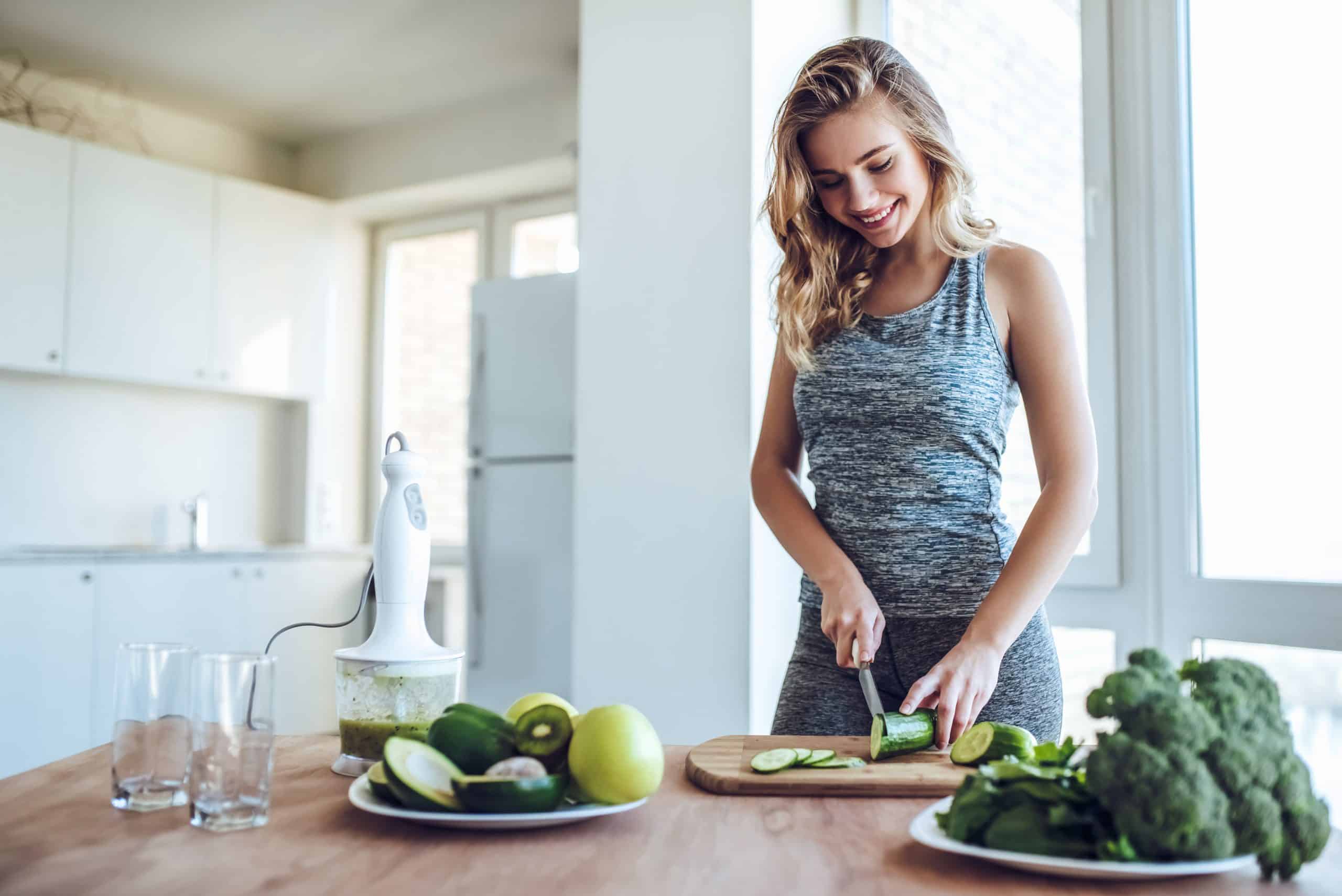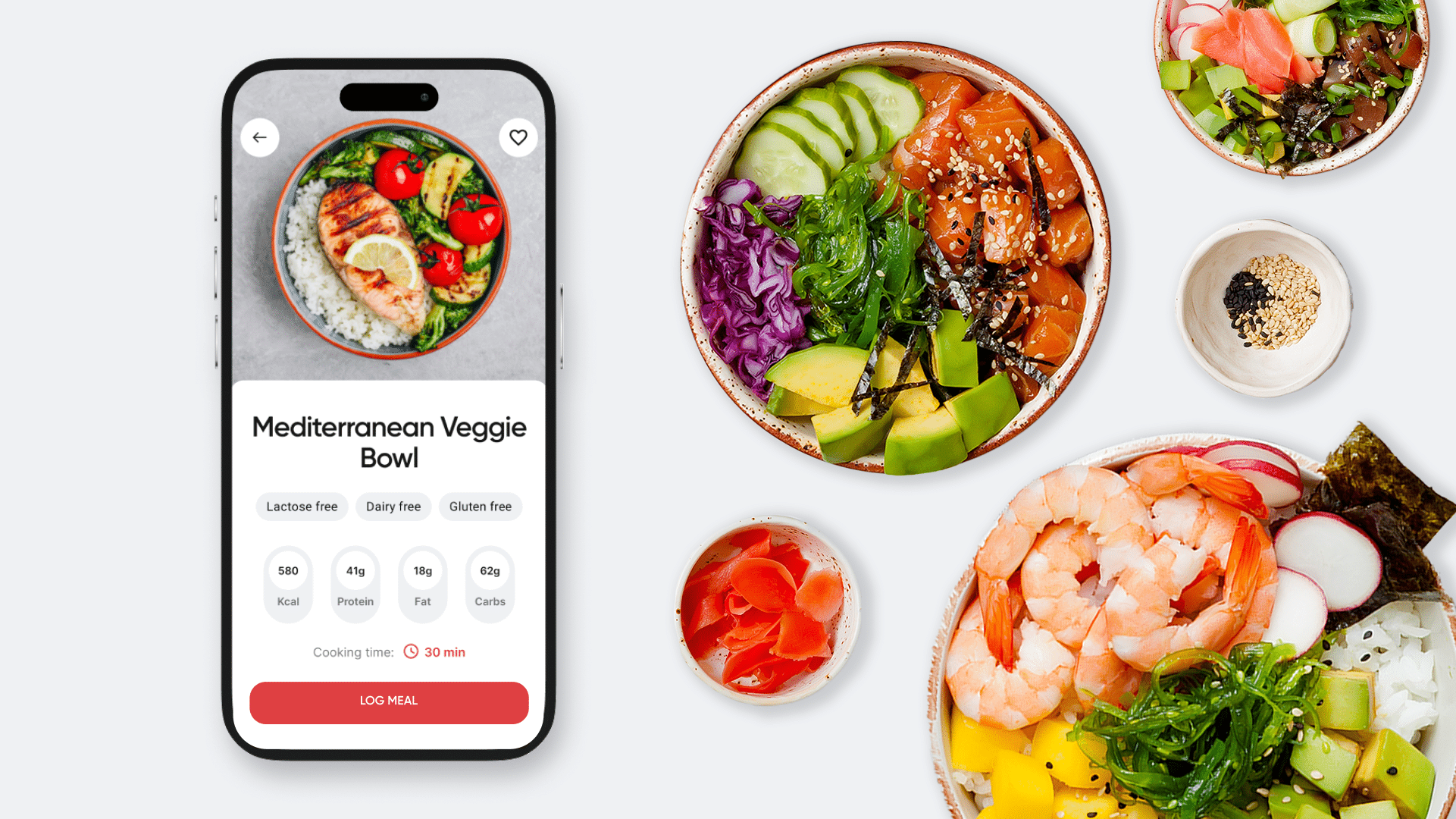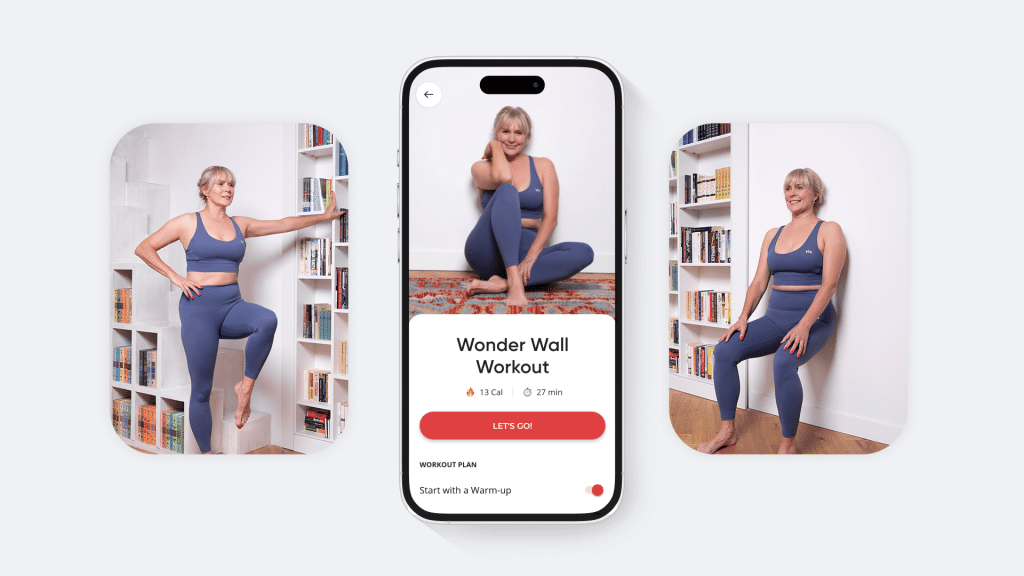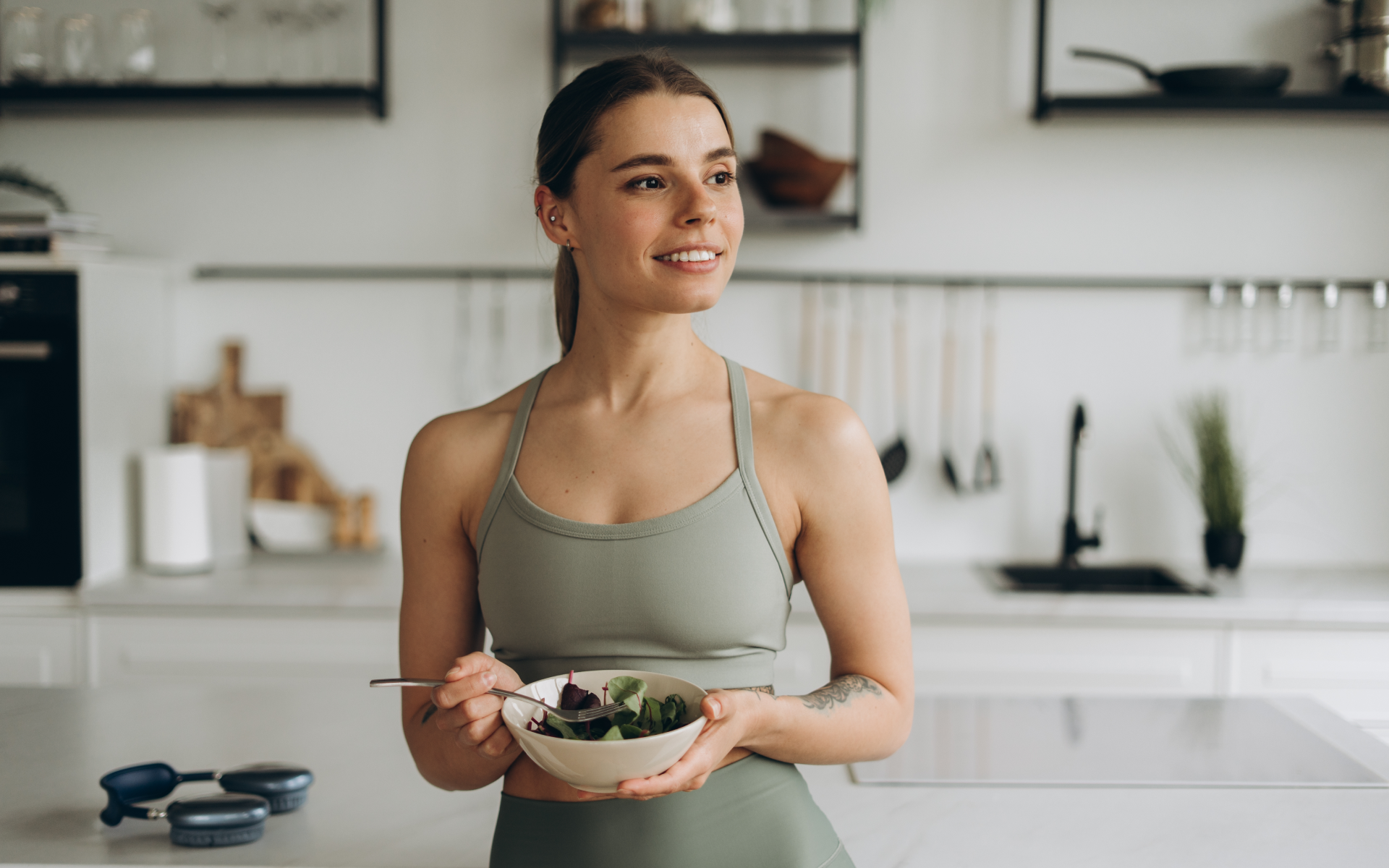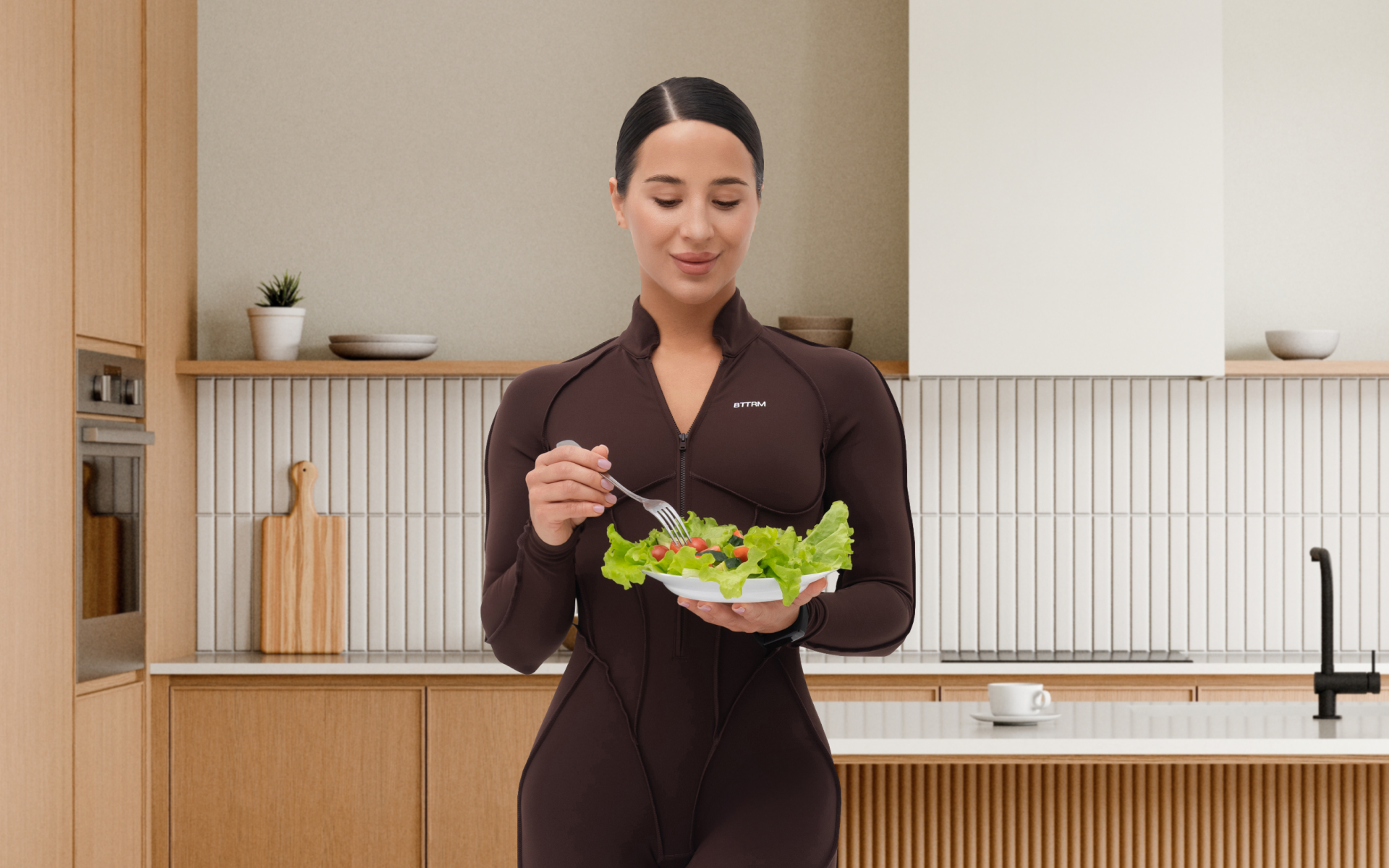Losing weight isn’t as easy as gaining it, that is the harsh truth. That said, the battle is not lost. Know that you’re not alone in your health journey, we’re here to help!
Exercise is undoubtedly a vital component, but so is diet, and we don’t mean restrictive diets, but the importance of good nutrition, and learning what to give your body during your weight loss journey.
In this article, we’ll focus on the fundamentals of nutrition and a meal plan to help you lose weight while gaining muscle.
What is a meal plan for weight loss and muscle gain in females?
Losing fat and gaining muscle are fairly common goals (1). These can be for aesthetic reasons, but deep down, the benefits are much greater than that. An adequate fat and muscle ratio is a cornerstone for overall health, especially as we age (2).
Before jumping to the basic nutrition rules that can help you achieve your goals, it’s worth mentioning that individual needs vary, and should be considered general advice. Talk with a registered dietitian for personalized guidance.
Protein
Protein is an essential nutrient for building and repairing muscle tissue, vital for increasing muscle mass, or maintaining it. Protein is also one of the most satiating nutrients, helping you feel full for longer (3).
High-protein diets can boost your metabolism, and help reduce ghrelin levels, the hunger hormone, making you feel fuller for longer, thereby helping reduce your calorie intake (4). On average, it is recommended that 10 to 35% of our total calorie intake should come from protein with the remaining calories coming from complex carbohydrates and healthy fats (5).
The minimum recommended daily allowance (RDA) for protein is 0.8 grams per kilogram of body weight. For example, for a person weighing 165 pounds, or 75 kilograms, the minimum daily protein intake should be 60 grams (6).
As we age, we start losing muscle mass, so we need higher intakes of about 1 to 1.2 grams of protein per kilogram of body weight, or between 75 and 90 grams per day for a 165-pound person.
On the other hand, the protein needs for athletes are even higher, up to 1.5 or 2 grams per kilogram of body weight, depending on the type of exercise and workout frequency. People aiming to lose weight may also benefit from protein intakes in this range, especially if they are exercising to maintain muscle mass.
Lean and toned up body isn’t just a far-fetched fantasy. Check out the BetterMe: Health Coaching app and watch it propel your weight loss journey into high gear!
Carbohydrates
Many people believe carbs should be removed for a healthy diet, but this is hardly the truth.
Three main types of carbs exist and each has unique characteristics: starches (or complex carbohydrates), fiber, and sugars (7).
The first two groups are essential for boosting our nutrition and aiding in weight loss and muscle-building goals, as they provide energy and satiety.
Fiber can slow down the absorption of nutrients and can reduce how many calories our bodies absorb from food. This means we feel full longer, aiding in lowering our overall caloric intake.
Adding foods rich in fiber and complex carbs, such as whole grains, pulses, fruits, and veggies will help promote your weight loss, while giving you an array of essential micronutrients. Foods rich in added sugars, such as refined grains, baked goods, candies, chocolates, soda, and other highly processed foods are usually high in empty calories, meaning they contribute to our overall caloric intake with only minimal nutritional benefits (8).
Fats
As with carbs, we have two major fat groups, saturated and unsaturated ones, also known as healthy fats.
Healthy fats are essential for health, they’re an energy source but also help support cell function, are needed for absorbing fat-soluble vitamins, are part of hormones, and can help reduce bad cholesterol levels (9)
As a general guide, between 20 and 35% of your total daily calories should come from healthy fats, this can help boost satiety, so making them part of your healthy diet is a must. Choose healthy fats such as avocados, nuts, seeds, and olive oil (5, 10).
Can a Woman Lose Weight and Gain Muscle at The Same Time?
Gaining muscle and losing weight simultaneously, often called body recomposition, is surely a goal for many women. Many people focus only on scale numbers while on their weight loss journey, so if the number isn’t dropping, what they’re doing is not working.
But the scale doesn’t differentiate fat from muscle, and this is a crucial factor in measuring health outcomes. Evidence shows that having a healthy ratio of muscle mass to body fat can improve our health while reducing the risk of chronic diseases including diabetes and heart disease (11, 12).
How Many Calories Should I Eat a Day to Lose Weight and Gain Muscle Woman?
There is no single answer here, as the ideal calorie intake for weight loss and muscle gain depends on age, height, weight, and activity level (13, 14)
Based on the Dietary Guidelines for Americans, adults’ caloric intake should be between 1,600 and 3,000 calories daily. But this is general guidance (15).
It’s important to remember that individual needs vary, so consulting a registered dietitian for personalized guidance is always a good idea.
A simple method to estimate our Total Daily Energy Expenditure (TDEE) is using the Mifflin-St. Jeor equation, either with online calculators (16) or manually, and multiply the result by our activity factor
For men
Calories per day = 10 x (weight in kg) + 6.25 x (height in cm) – 5 x (age) + 5
For women
Calories per day = 10 x (weight in kg) + 6.25 x (height in cm) – 5 x (age) – 161
The activity factor varies according to how physically active you are:
- Sedentary: 1.2. For sedentary people with little to no exercise.
- Lightly active: 1.375. For those who exercise 1 to 3 days per week.
- Moderately active: 1.55. For those with moderate exercise 4 to 5 days per week.
- Active: 1.725. For those with moderate to intense exercise every day.
- Very active: 1.9. For those with daily strenuous activity or more.
As a rule of thumb, to create a healthy calorie deficit that helps with our goals, we should subtract from this TDEE about 500-750 calories per day (17). Yet, to gain muscle mass we need to eat more calories than we burn. This sounds contradictory, right?
However, the right balance can help us achieve our goals. Slightly reducing our calorie intake while ensuring adequate protein, paired with exercise, especially resistance training, to support muscle growth and increase metabolism is key.
We will dive deeper into a full example shortly, so keep reading!!
Read more: 7 Day High Protein Meal Plan for Weight Loss and Muscle Gain
What Diet Is Best for Weight Loss and Muscle Gain?
As mentioned before, a rich-protein diet is essential. Protein is a vital nutrient for muscle building, and repairing muscle tissue, and it’s highly satiating, aiding in weight loss.
Aiming for a protein intake of 1.2 to 1.7 grams per kilogram of body weight is a good rule of thumb to start building muscle, but remember strength training is also crucial (18).
Here are some of the best protein-rich foods you can include (19):
- Chicken breast, raw: 3 oz – 27 grams
- Turkey breast, raw: 3 oz – 25 grams
- Ground beef, raw: 3 oz – 22 grams
- Salmon, raw: 3 oz – 22 grams
- Large egg: one unit – 6 grams
- Greek yogurt: 6 oz – 18 grams
- Cottage cheese: 1 cup – 12 grams
- Lentils, cooked: 1 cup – 18 grams
- Black beans, cooked: 1 cup – 15 grams
- Chickpeas, cooked: 1 cup – 14 grams
- Tofu: 3 oz – 8.5 grams
- Almonds: 1 oz – 6 grams
- Peanut butter: 2 tbsp – 8 grams
Apart from protein, complex carbs, fiber, and healthy fats must be part of our diet. This can provide our body with all the essential nutrients for building and repairing muscle tissue but also to support overall health and weight management.
Eating enough carbs and healthy fats is vital. Carbs are our main energy source and fuel our workouts, and healthy fats are essential for overall health. As general guidance, 45 to 65% of our daily calories from carbs and 20 to 35% from fats for a diet aligned with these goals (20, 21)
Best complex carbs and fiber-rich foods:
- Whole grains such as brown rice, quinoa, whole-grain bread, oats
- Pulses like lentils, chickpeas, and black beans (with the extra benefit of being rich in protein too)
- Fruits and veggies of all colors, raw and cooked.
Healthy fats sources:
- Avocados and olives
- Almonds, walnuts, cashews (preferably with no added salt or sugar)
- Chia seeds, flaxseeds, pumpkin seeds
- Olive oil and other vegetable oils
- Salmon, mackerel, sardines, and other oily fish (with the extra benefit of being rich in protein too)
What Foods Should I Avoid While Building Muscle?
There is no such thing as good or bad foods, there is no moral value associated with it.
But not all foods are equally nourishing. We all know that some taste better than others, but have little nutritional value, while others may provide greater satiety with tons of essential nutrients.
It’s important to remember that health is not entirely determined by what we eat, as it’s a complex process. Yet, what we eat can help improve our health.
To that extent, if you’re in pursuit of muscle building, ultra-processed foods should be limited as much as possible as they can quickly raise our calorie intake with little to no nutrients. You don’t have to remove them completely but rather enjoy them occasionally.
Ultra-processed foods include frozen meals, frozen pizza, pastries, chicken nuggets, packaged snacks, candy, fast foods, sugary drinks, and sugary breakfast cereals, to name a few.
Looking for a way to break the vicious cycle of weight loss and tone up all the jiggly parts? Watch the extra pounds fly off and your muscles firm up with the BetterMe: Health Coaching app!
How To Make a Meal Plan for Weight Loss and Muscle Gain?
This may seem a daunting task, but with some time and dedication, you can build a basic meal plan guide that can help you succeed in your weight loss and muscle-building journey!
Knowing and defining your goals and objectives for ideal weight and body composition is vital; a registered dietitian could provide valuable insight in this regard.
Determine Calorie Intake Goals
First, we should know our Total Daily Energy Expenditure (TDEE) using the Mifflin-St. Jeor equation (16).
For example, for a 35-year-old woman who is 163 cm tall and weighs 73 kg, and is moderately active, the calculation would be:
TDEE = 10 x 73 + 6.25 x 163 – 5 x 35 + 5 x 1.55 = 2200 calories per day.
If we consider a daily calorie deficit of 500, the adjusted caloric intake should be 1700 calories daily.
Finding your Macros Split
Now that we know how many calories we need, how much protein, carbs, and fats is the next question (22). Our macronutrient ratio, or split, refers to how much protein, carbs, and fats we should eat to reach our recommended caloric intake.
This ratio can vary, based on age, sex, activity levels, goals, and preferences, and we´ll show general guidance here to calculate yours. Nevertheless, personalizing your eating plan with the guidance of a registered dietitian can help further with your goals.
Protein
To build muscle while losing weight, we should create a slight calorie deficit while ensuring adequate protein intake. 1.2 grams of protein per kilogram of body weight is a good starting point.
Considering the previous example, for a 35-year-old woman who weighs 73 kg, protein intake should be 87.6 grams daily.
One gram of protein provides 4 calories, so 87.6 grams will provide 350 calories.
87.6 g protein x 4 calories per gram = 350 calories from protein
Of the 1700 caloric intake, 350 calories represent 20%
Protein’s % of daily calories = 350 ÷ 1700 (total calories) x 100 = ~20% protein
Fat
A 20% ratio of healthy fats intake, balanced with adequate protein and carbs intake, is usually good for muscle building.
If 20% of the total caloric intake should come from fats, this represents 340 calories.
Fat intake: 1700 daily calories x 0.20 (20% fat) = 340 calories from fat
One gram of fats provides 9 calories, so 340 calories will come from 37.8 grams of fat.
Grams intake: 340 calories ÷ 9 calories per gram = ~37.8 grams of fat daily
Carbohydrates
Last but not least, we have to determine carb intake, based on the remaining calories.
Protein: 20%
Fat: 20%
Carb percentage: 100% – 40% (protein + fat) = 60% from carbs
If 60% of the total caloric intake should come from fats, this represents 1020 calories.
Carb intake: 1700 daily calories x 0.60 (60% fat) = 1020 calories from carbs
One gram of carbs provides 4 calories, so 1020 calories will come from 255 grams of carbs.
Grams intake: 1020 calories ÷ 4 calories per gram= 255 grams of carbs daily
Creating a Balanced Meal Plan
This example is meant to guide you in finding your macro split:
- Calories: 1700
- Protein: 87.6 g (20%)
- Fat: 37.8 g (20%)
- Carbs: 255 g (60%)
Once you have the numbers, how do we translate it into meals?
Structuring 3 meals per day with 2 snacks can be a good starting point, always ensuring to add protein, complex carbs, fiber, and healthy fats.
Next, tracking your meals with the Better Me Calorie Tracker will help you know your overall intake and where you stand with your macro split to adjust if needed.
Read more: The Ultimate Lazy Girl Meal Plan: Eat Smart, Not Hard
Sample Meal Plan
Here is a sample meal plan based on our example (19, 23):
Bear in mind this is a sample meal plan and should be adjusted, based on individual needs and preferences.
- Calories: 1700
- Protein: 87.6 g (20%)
- Fat: 37.8 g (20%)
- Carbs: 255 g (60%)
Breakfast (350 calories):
Oats (1.5 oz), Greek yogurt (3 oz), berries (1/2 cup), walnuts (1/4 cup),
Lunch (450 calories):
Grilled chicken breast (4 oz), mixed greens salad (1 cup), avocado (¼ each), quinoa (1/2 cup, cooked).
Dinner (500 calories):
Salmon (4 oz), roasted vegetables (1 cup), brown rice (1/2 cup, cooked), side salad (1 cup)
Snacks (400 calories):
Cottage cheese (1/3 cup), fruit (1 medium unit)
Hummus (2 Tbsp), carrot, bell peppers, and celery sticks (1 cup)
FAQs
Is pasta good for muscle gain?
Some types of pasta, like those made with whole grains, provide complex carbs, which offer sustained energy for workouts, thus helping power a muscle-building diet.
Whole-grain pasta is also rich in fiber and other nutrients when compared to regular refined pasta.
Is rice good for weight loss?
Brown rice in particular can be a good option as it’s rich in complex carbs, fiber, and micronutrients. Fiber and complex carbs help boost satiety, meaning we feel full for longer aiding in reducing our overall calorie intake. Yet, portion control is important. Eating too much rice could mean we have a higher calorie intake, and the excess could be stored as fat.
Is 2 eggs a day unhealthy?
Eating 2 eggs daily is generally safe for most people, and not considered unhealthy. Eggs are a great source of protein, fats, and many vitamins and minerals. They can make a perfect protein-rich breakfast or snack. Nevertheless, if you suffer from high cholesterol levels, you should consult with your doctor to discuss whether 2 eggs a day is a good amount for you.
Is banana good for weight loss?
Bananas are high in fiber and essential nutrients, and relatively low in calories. This makes them a great snack option to boost your satiety with fewer calories.
Yet, as with any food, portion control is crucial while on your weight loss journey, since we need to keep a light caloric deficit to support our goals.
The Bottom Line
Losing weight while building muscle may be challenging, but a balanced approach combining a healthy diet and regular exercise can help with this goal. A moderate calorie deficit while ensuring adequate protein intake would be a pillar for success. And don’t forgo complex carbs, healthy fats, and fiber as they’re also a vital component for overall health that can support your journey.
Remember that individual needs may vary, so talking with a registered dietitian is always a good idea.
DISCLAIMER:
This article is intended for general informational purposes only and does not serve to address individual circumstances. It is not a substitute for professional advice or help and should not be relied on for making any kind of decision-making. Any action taken as a direct or indirect result of the information in this article is entirely at your own risk and is your sole responsibility.
BetterMe, its content staff, and its medical advisors accept no responsibility for inaccuracies, errors, misstatements, inconsistencies, or omissions and specifically disclaim any liability, loss or risk, personal, professional or otherwise, which may be incurred as a consequence, directly or indirectly, of the use and/or application of any content.
You should always seek the advice of your physician or other qualified health provider with any questions you may have regarding a medical condition or your specific situation. Never disregard professional medical advice or delay seeking it because of BetterMe content. If you suspect or think you may have a medical emergency, call your doctor.
SOURCES
- Body Recomposition: Can Trained Individuals Build Muscle and Lose Fat at the Same Time? (2020, journals.lww.com)
- The Utility of Body Composition Assessment in Nutrition and Clinical Practice: An Overview of Current Methodology (2021, ncbi.nlm.nih.gov)
- Are Dietary Proteins the Key to Successful Body Weight Management? A Systematic Review and Meta-Analysis of Studies Assessing Body Weight Outcomes after Interventions with Increased Dietary Protein (2021, ncbi.nlm.nih.gov)
- The role of protein in weight loss and maintenance (2015, sciencedirect.com)
- Fueling for Performance (2018, ncbi.nlm.nih.gov)
- Are you getting too much protein? (n.d, mayoclinichealthsystem.org)
- Food & Nutrition. Types of Carbohydrates (n.d, diabetes.org)
- Physiology, Carbohydrates (n.d, ncbi.nlm.nih.gov)
- Dietary Fats, Human Nutrition and the Environment: Balance and Sustainability (2022, frontiers.org)
- Fats and Satiety (n.d, ncbi.nlm.nih.gov)
- Body Fat Percentage Rather than Body Mass Index Related to the High Occurrence of Type 2 Diabetes (2021, sciencedirect.com)
- Body mass index and body composition about 14 cardiovascular conditions in UK Biobank: a Mendelian randomization study (2020, ncbi.nlm.nih.gov)
- How Many Calories Should You Eat in a Day? (n.d, health.clevelandclinic.org)
- Daily Energy Expenditure through the Human Life Course (2022, ncbi.nlm.nih.gov)
- Current Dietary Guidelines (n.d, health.gov)
- Mifflin-St Jeor Equation (n.d, reference.medscape.com)
- Steps for Losing Weight (n.d, cdc.gov)
- PROTEIN INTAKE FOR OPTIMAL MUSCLE MAINTENANCE (n.d, acsm.org)
- Food Data Central(n.d, usda.gov)
- How Many Carbs Do You Need To Lose Weight? (n.d, health.clevelandclinic.org)
- How Many Grams of Fat Per Day to Lose Weight? (n.d, nasm.org)
- Nutrition: Macronutrient Intake, Imbalances, and Interventions (n.d, ncbi.nlm.nih.gov)
- Eat this much (n.d, eatthismuch.com)
